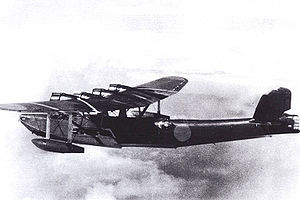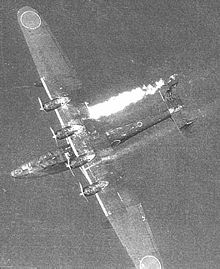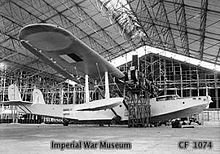Kawanishi H6K Video - Picture

|
|
Kawanishi H6K

Role: Patrol flying boat
Manufacturer: Kawanishi
First flight: 14 July 1936
Introduction: January 1938
Retired: 1945 (Japan)
Primary user: IJN Air Service
Number built: 215
The Kawanishi H6K was an Imperial Japanese Navy flying boat produced by the Kawanishi Aircraft Company and used during World War II for maritime patrol duties. The Allied reporting name for the type was Mavis; the Navy designation was "Type 97 Large Flying Boat" (ä¹ä¸å¼å¤§åé£è¡è).
Design and development

Airplane Picture - A H6K "Mavis" going down in flames. Note the graceful shape of the aircraft
The aircraft was designed in response to a Navy requirement of 1934 for a long range flying boat and incorporated knowledge gleaned by a Kawanishi team that had visited the Short Brothers factory in the UK, at that time one of the world's leading producers of flying boats, and from building the Kawanishi H3K, a license-built, enlarged version of the Short Rangoon. The Type S, as Kawanishi called it, was a large, four-engine monoplane with twin tails, and a hull suspended beneath the parasol wing by a network of struts. Three prototypes were constructed, each one making gradual refinements to the machine's handling both in the water and in the air, and finally fitting more powerful engines. The first of these flew on 14 July 1936 and was originally designated Navy Type 97 Flying Boat, later H6K. Eventually, 217 would be built.
Operational history
H6Ks were deployed from 1938 onwards, first seeing service in the Sino-Japanese War and were in widespread use by the time the Pacific War full-scale erupted, in 1942. At that time of the war, four kokutai operated a total of 66 H6K4s.
The type had some success over South East Asia and the South West Pacific. H6Ks had excellent endurance, being able to undertake 24-hour patrols, and was often used for long-range reconnaissance and bombing missions. From bases in the Dutch East Indies, they were able to undertake missions over a large portion of Australia.
However, the H6K became vulnerable to a newer generation of heavier armed and faster fighters. It continued in service throughout the war, in areas where the risk of interception was low. In front-line service, it was replaced by the Kawanishi H8K.
Variants

Airplane Picture - A H6K2-L Navy Transport Flying Boat Type 97
H6K1
Evaluation prototypes with four Nakajima Hikari 2 engines, 4 built.
H6K1 (Navy Flying Boat Type 97 Model 1)
Prototypes with 746 kW 1,000 hp Mitsubishi Kinsei 43 Engines, 3 converted from the original H6K1 prototypes.
H6K2 Model 11
First production model. Includes two H6K2-L officer transport modification, 10 built.
H6K2-L (Navy Transport Flying Boat Type 97)
Unarmed transport version of H6K2 powered by Mitsubishi Kinsei 43 engines, 16 built.
H6K3 Model 21
Modified transport version of H6K2 for VIPs and high ranking officers, 2 built.
H6K4 Model 22
Major production version, modified H6K2 with revised weapons, some with 694 kW (930 hp) Mitsubishi Kinsei 46 engines. Fuel capacity increased from 7,764 L (1,708 Imp gal) to 13,410 L (2,950 Imp gal). Includes two H6K4-L transport versions, 100 to 127 (if other numbers are all correct) built.
H6K4-L
Transport version of H6K4, similar to H6K2-L, but with Mitsubishi Kinsei 46 engines, 20 built and another two converted from the H6K4.
H6K5 Model 23
Fitted with 969 kW (1,300 hp) Mitsubishi Kinsei 51 or 53 engines and new upper turret replacing the open position, 36 built.
Operators

Airplane Picture - Royal Air Force mechanics inspecting a H6K at Soerabaja, Java, prior to a test flight in January 1946. Note the Indonesia flag added by nationalists and the additional blue band added to the fuselage marking by the Dutch
Indonesia
Air Service Volunteer Corps - A single H6K5 flying boat was restored to flight by Indonesian forces during the Indonesian War of Independence.
Japan
Imperial Japanese Navy Air Service
Imperial Japanese Airways
Used on the routes Yokohama-Saipan-Koror (Palau)-Timor, Saigon-Bangkok and Saipan-Truk-Ponape-Jaluit.
Specifications (H6K4)
Data from Warplanes of the Second World War, Volume Five: Flying Boats; Japanse Aircraft of the Pacific War
General characteristics
Crew: 9
Length: 25.63 m (84 ft 3 in)
Wingspan: 40.00 m (131 ft 2 in)
Height: 6.27 m (20 ft 6 in)
Wing area: 170 m<sup2 (1,830 ft<sup2)
Empty weight: 11,707 kg (25,755 lb)
Loaded weight: 17,000 kg (37,400 lb)
Max takeoff weight: 21,500 kg (47,300 lb)
Powerplant: 4 x Mitsubishi Kinsei 43 or 46 14-cylinder, air-cooled, radial engines, 746 kW (1,000 hp) each
Performance
Maximum speed: 331 km/h (211 mph)
Cruise speed: 138 mph
Range: 6,580 km (4,112 mi)
Service ceiling: 9,610 m (31,520 ft)
Rate of climb: 370 m/min (1,213 ft/min)
Wing loading: 100 kg/m<sup2 (20 lb/ft<sup2)
Power/mass: 0.17 kW/kg (0.11 hp/lb)
Armament
1x 7.7 mm (0.30 in) Type 97 machine gun in nose
1x Type 97 machine gun in spine
2x Type 97 machine guns in waist blisters
1x 20 mm Type 99 cannon in tail turret
2x 800 kg (1,764 lb) torpedoes or 1,000 kg (2,205 lb) of bombs
Comparable aircraft
Dornier Do 24
PBY Catalina
Bibliography
Doubilet, David. "The Flying Boat". Sport Diver Magazine. Volume 15, Number 8, September 2007.
Francillon, Ph.D., René J. Japanese Aircraft of the Pacific War. Annapolis, Maryland, MD: Naval Institute Press, 1995.
Green, William. Warplanes of the Second World War, Volume Five: Flying Boats. London: Macdonald & Co.(Publishers) Ltd., 1962. ISBN 0-356-01449-5.
"Kawanishi's Parasol Patroller". Air International, December 1985, Volume 29, No. 6. Bromley, UK: Fine Scroll. pp. 293-298, 304-305.
"Pentagon Over The Islands...The Thirty Year History of Indonesian Military Aviation". Air Enthusiast Quarterly. No. 2, 1976. pp. 154-162.
Richards, M.C. "Kawanishi 4-Motor Flying-Boats (H6K 'Mavis' and H8K 'Emily')". Aircraft in Profile Volume 11. Windsor, Berkshire, UK: Profile Publications Ltd., 1972.
Van der Klaauw, Bart. Water- en Transportvliegtuigen Wereldoorlog II (in Dutch). Alkmaar, the Netherlands: Uitgeverij de Alk. ISBN 90-6013-6772.
Kawanishi H6K Pictures
More airplane video.
Source: WikiPedia